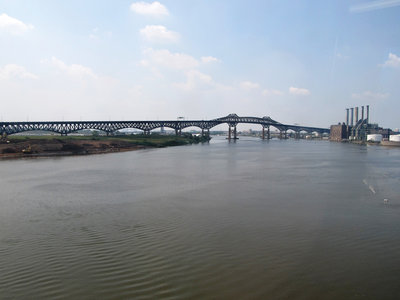The City Council learned the bad news at the Feb. 10 caucus meeting.
The closing of the Pulaski Skyway in March will likely cause massive traffic backups in Jersey City and throughout Hudson County as cars bound for Hoboken and the Holland Tunnel scramble to find to find alternate routes.
The 81-year-old bridge between Jersey City and Newark will be closed to New York-bound traffic as the road surface is replaced over a two year period. Outbound traffic will be permitted during a significant portion of the reconstruction.
The city is developing a plan to handle the massive disruption of traffic patterns with the closing of the Skyway. Parking and traffic changes are required in order to maintain optimum traffic circulation on city streets.
City officials admit that the city will be operating in a “crisis mode” during the two years of repair.
In the plan, according to Muhammed Akil, chief of staff to Mayor Steve Fulop, turns off certain city streets will be prohibited during the morning rush hour to keep commuters from taking short cuts through residential neighborhoods.
“We do not want cars going through residential neighborhoods looking for faster routes to the riverfront,” Akil said.
Getting traffic through the city
The council members on Jan. 11 approved the introduction of an ordinance that outlined general changes to traffic routes in Jersey City. The most impact will be felt on Communipaw Avenue.
All turns off Communipaw Avenue at West Side Avenue and Bergen Avenue will be banned. Left hand turns from Communipaw going east onto Grand Street, Brook Street, Columbus Drive, Bright Street, York Street and North onto Ivy Place, Park Street, Barrow Street, and Marin Boulevard, and right turns onto Center Street will be banned Monday through Friday, 6 to 10 a.m.
During those times, the city will have police officers on critical corners to keep intersections from gridlock. This will mean tough enforcement against those blocking intersections. Existing rules prohibiting stopping and standing on streets in the area will be enforced, officials said.
“We’re going to be in a crisis management mode for the next two years.” – Muhammed Akil.
____________
But alternate routes will affect the whole of Hudson County since alternate routes include the Route 3 bridge in Secaucus, the Newark Turnpike-Route 7 bridge from Kearny, the 1&9 truck route near the Hudson Mall, and the already-overcrowded Turnpike Extension Bridge crossing near Bayonne.
An organized effort
The DOT will be using new technology to upgrade traffic signals at a number of intersections in Hudson County in order to improve traffic flow.
This is not the first time the Skyway as been closed, said Council Richard Boggiano. Repairs to the historic roadway were also done over a two-year period in the 1980s.
“But there wasn’t as much traffic then,” Boggiano said.
The northern lanes of the bridge will be closed in the spring.
The DOT and a group of local officials have met a number of times to determine how to steer traffic through Jersey City.
Many commuters will be going to New York and to the core areas of Jersey City and Hoboken. The plan will force traffic onto the predetermined routes.
“The idea is to keep traffic onto the main thoroughfares,” Akil said. “We want to prevent traffic from seeking other ways through the city that might be deemed as faster when this would cause havoc in neighborhoods.”
Councilwoman Diane Coleman said Communipaw Avenue, which will be one of the main west-to-east thoroughfares from the bridge at Route 440, already has traffic gridlock during rush hour. She said she’s seen people stuck in traffic there as long as two hours.
“With this, instead of two hours, people will be stuck for three,” she said.
Coleman suggested that city officials get people from DOT to physically observe traffic patterns in the affected areas.
Akil said they have, and have also reviewed camera footage of traffic in the area.
Akil said a fuller presentation of the new plans will be made to the City Council in the near future.
New signs are being made by the Department of Public Works detailing the changes, Akil said.
“We’re going to be in a crisis management mode for the next two years,” Akil said, adding that Jersey City was not built to handle the kind of traffic that will result from the closures.
While plans do not yet call for turn and other restrictions elsewhere in the city such as in Jersey City Heights, that could change in the future, Akil said.
City officials are also making some provisions for areas around schools, hospitals, and firehouses. A tabletop exercise for emergency responders is also scheduled.
The city will have to change protocol for things like public utilities street closings, although in the midst of the changes, the city will be rebuilding some of the sewerage piping.
The cost of manpower and equipment will be significant, Akil said. Discussions are underway with the DOT to get state funding to help.
Al Sullivan may be reached at asullivan@hudsonreporter.com.
